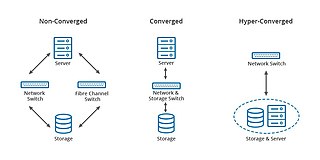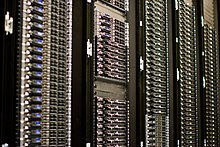Grid computing is the use of widely distributed computer resources to reach a common goal. A computing grid can be thought of as a distributed system with non-interactive workloads that involve many files. Grid computing is distinguished from conventional high-performance computing systems such as cluster computing in that grid computers have each node set to perform a different task/application. Grid computers also tend to be more heterogeneous and geographically dispersed than cluster computers. Although a single grid can be dedicated to a particular application, commonly a grid is used for a variety of purposes. Grids are often constructed with general-purpose grid middleware software libraries. Grid sizes can be quite large.
In software engineering, the terms frontend and backend refer to the separation of concerns between the presentation layer (frontend), and the data access layer (backend) of a piece of software, or the physical infrastructure or hardware. In the client–server model, the client is usually considered the frontend and the server is usually considered the backend, even when some presentation work is actually done on the server itself.
IT disaster recovery is the process of maintaining or reestablishing vital infrastructure and systems following a natural or human-induced disaster, such as a storm or battle. It employs policies, tools, and procedures. Disaster recovery focuses on information technology (IT) or technology systems supporting critical business functions as opposed to business continuity. This involves keeping all essential aspects of a business functioning despite significant disruptive events; it can therefore be considered a subset of business continuity. Disaster recovery assumes that the primary site is not immediately recoverable and restores data and services to a secondary site.
NetApp, Inc. is an intelligent data infrastructure company that provides unified data storage, integrated data services, and cloud operations (CloudOps) solutions to enterprise customers. The company is based in San Jose, California. It has ranked in the Fortune 500 from 2012 to 2021. Founded in 1992 with an initial public offering in 1995, NetApp offers cloud data services for management of applications and data both online and physically.
A configuration management database (CMDB) is an ITIL term for a database used by an organization to store information about hardware and software assets. It is useful to break down configuration items into logical layers. This database acts as a data warehouse for the organization and also stores information regarding the relationships among its assets. The CMDB provides a means of understanding the organization's critical assets and their relationships, such as information systems, upstream sources or dependencies of assets, and the downstream targets of assets.
Capacity management's goal is to ensure that information technology resources are sufficient to meet upcoming business requirements cost-effectively. One common interpretation of capacity management is described in the ITIL framework. ITIL version 3 views capacity management as comprising three sub-processes: business capacity management, service capacity management, and component capacity management.
Desktop virtualization is a software technology that separates the desktop environment and associated application software from the physical client device that is used to access it.
Infrastructure as a service (IaaS) is a cloud computing service model by means of which computing resources are supplied by a cloud services provider. The IaaS vendor provides the storage, network, servers, and virtualization. This service enables users to free themselves from maintaining an on-premises data center. The IaaS provider is hosting these resources in either the public cloud, the private cloud, or the hybrid cloud.
In computing, virtualization or virtualisation in British English is the act of creating a virtual version of something at the same abstraction level, including virtual computer hardware platforms, storage devices, and computer network resources.

Cloud computing is the on-demand availability of computer system resources, especially data storage and computing power, without direct active management by the user. Large clouds often have functions distributed over multiple locations, each of which is a data center. Cloud computing relies on sharing of resources to achieve coherence and typically uses a pay-as-you-go model, which can help in reducing capital expenses but may also lead to unexpected operating expenses for users.

Converged infrastructure is a way of structuring an information technology (IT) system which groups multiple components into a single optimized computing package. Components of a converged infrastructure may include servers, data storage devices, networking equipment and software for IT infrastructure management, automation and orchestration.
Middleware is a type of computer software program that provides services to software applications beyond those available from the operating system. It can be described as "software glue".

Cloud computing architecture refers to the components and subcomponents required for cloud computing. These components typically consist of a front end platform, back end platforms, a cloud based delivery, and a network. Combined, these components make up cloud computing architecture.
Software-defined storage (SDS) is a marketing term for computer data storage software for policy-based provisioning and management of data storage independent of the underlying hardware. Software-defined storage typically includes a form of storage virtualization to separate the storage hardware from the software that manages it. The software enabling a software-defined storage environment may also provide policy management for features such as data deduplication, replication, thin provisioning, snapshots and backup.
Network functions virtualization (NFV) is a network architecture concept that leverages IT virtualization technologies to virtualize entire classes of network node functions into building blocks that may connect, or chain together, to create and deliver communication services.
Software-defined data center is a marketing term that extends virtualization concepts such as abstraction, pooling, and automation to all data center resources and services to achieve IT as a service (ITaaS). In a software-defined data center, "all elements of the infrastructure — networking, storage, CPU and security – are virtualized and delivered as a service."
In computer networking, a bare-metal server is a physical computer server that is used by one consumer, or tenant, only. Each server offered for rental is a distinct physical piece of hardware that is a functional server on its own. They are not virtual servers running in multiple pieces of shared hardware.
The industrial internet of things (IIoT) refers to interconnected sensors, instruments, and other devices networked together with computers' industrial applications, including manufacturing and energy management. This connectivity allows for data collection, exchange, and analysis, potentially facilitating improvements in productivity and efficiency as well as other economic benefits. The IIoT is an evolution of a distributed control system (DCS) that allows for a higher degree of automation by using cloud computing to refine and optimize the process controls.
Data center management is the collection of tasks performed by those responsible for managing ongoing operation of a data center. This includes Business service management and planning for the future.
In computer networking, east-west traffic is network traffic among devices within a specific data center. The other direction of traffic flow is north-south traffic, data flowing from or to a system physically residing outside the data center.





